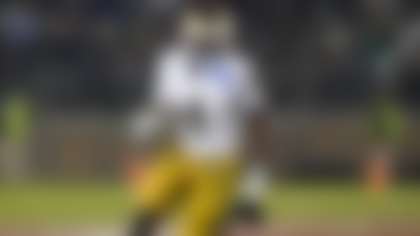Rex Burkhead's plunge into a frigid Arrowhead end zone sent the Patriots to Super Bowl LIII, where a player who was drafted even lower than Burkhead -- from Kent State, no less -- would win MVP en route to helping New England capture yet another Lombardi Trophy.
An uber-successful franchise leaned on two players who, not so long ago, barely merited a draft pick to make key plays in a championship run.
Oh, and before the playoffs even began, Broncos running back Phillip Lindsay became the first undrafted offensive rookie to make a Pro Bowl.
It was the acquisition of players just like Burkhead, Lindsay and Julian Edelman that launched an important and underrated name into the Pro Football Hall of Fame's Class of 2019:
Gil Brandt.
You might know him from your Twitter timeline. Maybe you know he was the central personnel force behind "America's Team." Or perhaps you go deeper with your NFL history, and you know the story of Steelers castoff Preston Pearson, who scored three touchdowns for the Cowboys in their win over the Rams in the 1975 NFC title match -- setting up a showdown with Pittsburgh in Super Bowl X.
Dallas coach Tom Landry received much credit for making Pearson the first "third-down back" in league lore. Quarterback Roger Staubach got the love for tossing Pearson those three touchdown passes.
Cool. But somebody had to go out and get Pearson. And that somebody was Brandt.
Dallas' personnel czar for three decades, Brandt gift-wrapped Landry and Staubach a passing-game weapon by signing Pearson off the street. It should be noted Brandt also drafted Staubach, spending a 10th-round "future" on a phenom quarterback from Navy. The only hitch in Staubach's scouting report was a four-year commitment to the Navy.
But the selection of Staubach is a relatively well-traveled story. Ditto for Brandt's nabbing Hall of Famer Bob Hayes with another future pick in 1964, banking on the Olympic speedster turning to football a year later. When Brandt was named as a Contributor nominee for the Hall's Class of 2019, these career highlights were among many underlined as qualifications.
Brandt identified and assisted in his organization drafting eight Hall of Famers, including Michael Irvin. He made a blockbuster draft trade for the ages, acquiring the second overall pick to secure one of those Hall of Famers, Tony Dorsett, in 1977. That season, Dorsett pushed the all-we-need-is-a-threat-at-tailbackCowboys to a win in Super Bowl XII. Brandt also flipped the scouting world on its axis by bringing in information technology and using computer programming to help narrow down prospects. This was such a jolt to the system that it must have seemed like Captain Kirk crash-landing into the Cotton Bowl. Organizations simply weren't using I.T. to try to land the next Jim Brown. Brandt made the futuristic mainstream.
His legacy goes beyond all of the above accomplishments. Brandt also shined at finding impactful talent off the beaten path. Whereas Landry had final say over who the team drafted, the realm of the undrafted was the battlefield Brandt oft roamed unchecked -- and conquered. Throw in the bargain-bin free agents trying to find work (even if they weren't always trying to find it in pro football), and Brandt had the ideal playground to discover players where other organizations didn't.
He merely had to know the right places to look. You know, like basketball courts, gas stations and colleges you've never heard of ...
Let's consider five of Brandt's biggest scouting coups.
BRANDT'S BIG FIVE
1) Cornell Green
Perhaps Brandt's most unique find came in the person of former basketball player Cornell Green. Like Preston Pearson, Green never played a lick of college football -- but the fact that Green paid off so handsomely for Dallas might have helped convince the Colts to take a chance on Pearson when he first entered the league.
Green is one of the top basketball players in Utah State history. The supremely athletic small forward helped the Aggies make it to the N.I.T. (which was a much more prestigious tournament then than it is now) in 1960 and to the NCAA tournament in '62. Later that year, Brandt signed Green (on a $1,000 bonus) with the idea of playing him at corner. Green -- who originally had no intention of sticking in professional football -- not only started a handful of games as a rookie, but he also made the All-Rookie team. In 1966, he was named first-team All-Pro. In 1970, Landry moved Green over to safety to strengthen an injury-depleted secondary. He made the Pro Bowl there in 1971 and '72, while helping the Cowboys win their first Super Bowl. In other words, Brandt morphed an out-of-the-box personnel move into a slam dunk.
2) Cliff Harris
As of 1970, Dallas had Hall of Famers Mel Renfro and Herb Adderly at the corners and Green at safety. That year, Brandt found someone who would go on to round out the secondary and become arguably the Cowboys' top defensive player of the decade: Cliff "Captain Crash" Harris. To find him, all Brandt had to do was go on one of his small-college deep dives -- we're talkin' a teeny-weeny school trek.
Harris -- who made six Pro Bowls, was named first-team All-Pro three times and started five (five!) Super Bowls -- came from ... from ... Ouachita Baptist University? Who hasn't heard of THE OBU? Well, Brandt definitely had. He got their NCAA Division II track star and football player signed to a deal to come to camp, and Harris became a starter immediately. He could run, and boy could he hit. Harris was bald (at 22), wore kicker's pads and donned the awkward-looking No. 43, not exactly known as an iconic secondary number. Think of a supercharged, more handsome Danny DeVito launching himself into receivers over the middle of the field. That was Harris.
The veterans appreciated Harris' spark. Later on, Harris became a leader on "Doomsday II," the Dallas defense that made Craig Morton look like Norris Weese in Super Bowl XII. It also made Norris Weese look like Norris Weese in Super Bowl XII. Coupled with Charlie Waters, Dallas owned the premier pair of safeties in the NFL. Harris was eventually named first-team All-Decade by the Hall of Fame.
3) Drew Pearson
Ask Harris or any of Landry's other defensive backs who the toughest guy to cover in practice was -- not in terms of speed, but craftiness -- and they might say Drew Pearson. Another of Brandt's undrafted free-agent gems, Pearson started off as a diamond in the rough at Tulsa. In the NFL, he became a bigger diamond in a sea of diamonds, mastering the art of wide receiver.
The 1970s featured an abundance of phenomenal big-play talents at wideout, including Paul Warfield, Mel Gray, Cliff Branch, Lynn Swann and a pair of Harolds (Harold Carmichael and Harold Jackson); Pearson made as many iconic plays as any of them. If you're talking about a knack for the spectacular, only Swann's catalogue could rival that of Dallas' own No. 88. There was Pearson's game-winner against the Rams in the 1973 playoffs, splitting two defensive backs. Or when he hauled in Clint Longley's moonball to win Thanksgiving's most memorable football game the next year. Or when he secured the first Hail Mary in NFL history, sending the Vikings to another Lombardi-less offseason in the 1975 playoffs.
When Brandt and staff signed Pearson in 1973, the master plan was merely to obtain depth and maybe special teams help. The Cowboys were grooming Otto Stowe to be their WR1. Their old primary option, Hayes, was to be a dangerous complement. Coupled with high draft pick Billy Joe DuPree at tight end, Dallas was set in the passing game. Then Stowe got hurt, as did his backup. The next thing anyone knew, Pearson was performing like a seasoned vet.
One factor that came into play: the extra work Pearson logged in the spring with Roger Staubach. The franchise quarterback had missed most of the previous season to injury, and his immensely competitive nature necessitated extra reps. That necessitated additional hands to catch his footballs. Enter Pearson, who worked overtime with Staubach before evolving into the most clutch wideout this side of Swann and Jerry Rice. Like Green and Harris, he would help the Cowboys win the Super Bowl. Like both, he would be named first-team All-Pro multiple times. Just another undrafted boon, delivered courtesy of the Brandt personnel department.
4) Everson Walls
Pearson owned a legendary pair of hands. That's a common attribute for the ultimate wideout. Not so much among corners -- unless you happen to be talking about Everson Walls.
Brandt scouted Walls at his final college game against Boise State. Speaking later to the Dallas Morning News, Brandt marveled at Walls' ability in an area you hear scouts today talk about all the time: ball skills.
"He just had that sense of going for the ball. If he was in a flat foot race, he'd get beat. But his sense of turning at the right time was a big thing. Another thing about Walls was his ability to find the ball. He didn't jump too soon."
No, he didn't. There was his leaping interception to beat the Giants in a key NFC East matchup in '85. Or his jump over Jerry Rice later that year, Walls' ninth interception of the season, which marked the third time he led the league. Only one other player has ever accomplished that: Ed Reed. I can guaran-damn-tee you Reed was no undrafted free agent.
Walls grew up in what was then North Dallas, essentially walking distance from the Cowboys' old practice facilities. Brandt rolled the dice on the local kid who played for Eddie Robinson at Grambling, a gamble that paid off because of Walls' on-field gambling habits. Nobody could bait a quarterback into throwing into an apparent window -- only to come out with an interception -- quite like this rookie free agent. Walls joined other Brandt rookie free agent finds Michael Downs and Ron Fellows, retooling the weakness of the Dallas defense en route to consecutive appearances in the NFC Championship Game in 1981 and '82.
Walls would go on to win a Super Bowl with the Giants, calling defensive signals for then-defensive coordinator Bill Belichick. He wound up picking off 57 career passes. Finally, consider this, from the Department of Stats That Will Make You Rethink Football: Walls intercepted 20 balls in his first 27 career games. Read that last line again.
5) Chuck Howley
Brandt's greatest, oddest, wrap-them-all-in-a-free-agent-burrito find in his 29 years running the Cowboys' scouting department was, without question, Chuck Howley.
Howley was no undrafted prospect of ill repute. George Halas and the Bears thought enough of him to spend the seventh overall pick on Howley in 1958. But by 1960, Howley was running a gas station in West Virginia.
So here comes Brandt, driving toward Wheeling, West Virginia and in need of a fill-up. Note that the Cowboys personnel czar was his own assistant and intern, too. Despite his pivotal role in what grew into a premier franchise, Brandt wasn't like Mick Jagger and The Stones rocking out Wembley. He was more like a dude with a guitar in a coffee shop, a one-man band scouting players not much younger than him for an NFL expansion franchise rushed into the league so fast that it missed the 1960 college draft. A team in need of a talent infusion like, oh, yesterday.
And on his way to scout a player named "Cannonball" Cooper, Brandt ran into Howley -- a guy at a filling station with a lot more football ability than most of the linebackers in pro football. Howley knew he could still play after wreaking havoc in a WVU alumni game. But he had hurt his knee with the Bears and decided he could do better financially, based on what Halas offered him, by operating a gas station.
Brandt traded Halas two draft picks for Howley, and the speedy weakside 'backer played at a high level from 1961 all the way through the '72 season. By that time, he had won a Super Bowl and a Super Bowl MVP (despite playing for the losing team in that game), and he'd been named first-team All-Pro five times. Howley maintained his top-shelf status as an outside linebacker into his mid-30s.
Redskins linebacker (and future NFL head coach) Jack Pardee put the players' admiration for the veteran succinctly, saying, "Howley is an inspiration to us all."
Thirty-five-year-old defenders just weren't supposed to make the plays Howley made on the reg. And to think: If not for Brandt, his career could've been over at 25.
A Hall-uva contribution to the NFL
Brandt's handiwork -- whether he was discovering the above-named players or helping draft small-school prospects like Ed "Too Tall" Jones, Harvey Martin and Jethro Pugh -- is a big reason he's Canton-bound. But viewing Brandt through the prism of his wonderful resume with the Cowboys alone sells Brandt's Hall status short. As any key "contributor" in any industry can attest, sphere of influence is really the benchmark by which they should be judged. In this regard, Brandt can't be matched.
His aforementioned use of programming to categorize every player's measurables -- basically modern-day profiling -- came years before the first NFL Scouting Combine. To that end, Brandt was one of the first scouts to plug in real figures for college prospects (like times in the 40-yard dash), thus freeing teams from having to rely on school propaganda and potentially rotten data. Brandt's innovative approach transformed an area of the NFL sorely wanting for organization and reach while laying the foundation for on-field success in Dallas.
Landry and former Cowboys president and general manager Tex Schramm each have busts in Canton. Both would surely have told you they didn't get there alone. It didn't matter to Brandt where his prospects came from. How many other teams would have even considered a guy like Harris, with his Ouachita Baptist pedigree? Now there's a college football award given in Harris' name. Brandt's deft ability to amplify the potential of the non-blue chippers provided a blueprint for teams to even the playing field, regardless of how many picks they held. That included paving the way for athletes from other sports, like Green.
Antonio Gates, anyone?
Bet you a Buffalo nickel that scouting departments in the NBA or the MLB were also influenced by Brandt's approach. (SEE: "Moneyball.") Put another way: Scouting matters. Until now, career personnel men like Brandt have been largely overlooked -- just like so many of the stars he unearthed. This honor has been a long time coming.
Follow Elliot Harrison on Twitter @HarrisonNFL.




